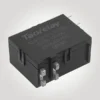A bistable latching relay is a type of relay that maintains its position after being actuated, without requiring continuous power to remain in that state. Unlike conventional electromagnetic relays that need constant voltage to hold a contact position, bistable relays “latch” in place using magnetic or mechanical means. This unique feature makes them highly energy-efficient, ideal for power-sensitive applications.
Bistable relays are widely used in systems where the control signal needs to remain stable even during power outages. They are especially useful in smart grids, industrial automation, and energy meters. With increasing demand for energy-saving solutions, the bistable latching relay has become a preferred choice for engineers and system designers.

How Does a Bistable Latching Relay Work?
A bistable latching relay typically uses two coils (or a single coil with polarity switching) to control its two stable states. When a pulse is sent to the first coil, the relay switches to one position. When a pulse is sent to the second coil, it switches to the other. No current is needed between these switching operations, meaning the relay can “remember” its last position indefinitely without power.
This bistable behavior is achieved through:
- Permanent magnets
- Magnetic latching mechanisms
- Mechanical spring systems
Key Features and Advantages
Here are the main features and benefits of using a bistable latching relay:
- Ultra-low power consumption (only during switching)
- Stable contact position during power loss
- Long electrical life due to reduced coil heating
- Compact design suitable for space-constrained installations
- Silent operation compared to mechanical relays
- High reliability in switching critical loads
- Dual-coil and single-coil options available for flexible control
Common Applications
Bistable latching relays are used across a variety of industries and applications, including:
- Smart meters and energy monitoring systems
- Home automation (lighting control, HVAC systems)
- Telecommunications equipment
- Battery-powered devices
- Industrial controls and PLCs
- Solar and renewable energy systems
- Electric vehicle charging stations
- Medical devices requiring memory switching
These relays are especially beneficial in applications where minimizing standby power is critical.
Choosing the Right Bistable Relay
When selecting a bistable latching relay, consider the following specifications:
- Rated voltage and current
- Coil voltage (single-coil or dual-coil)
- Contact configuration (SPST, SPDT, DPDT, etc.)
- Switching capacity and frequency
- Mounting options (PCB, DIN rail, plug-in)
Additionally, always ensure the relay meets relevant certifications such as UL, CE, or RoHS for your target markets.
Conclusion
The bistable latching relay is a powerful and efficient solution for modern control systems. Its ability to retain position without power makes it indispensable in many energy-conscious and mission-critical environments. Whether you’re designing smart devices or industrial controls, incorporating a bistable relay can significantly reduce energy usage and improve system resilience.
For reliable, high-quality bistable latching relays, choose a trusted manufacturer with experience in precision switching solutions.




